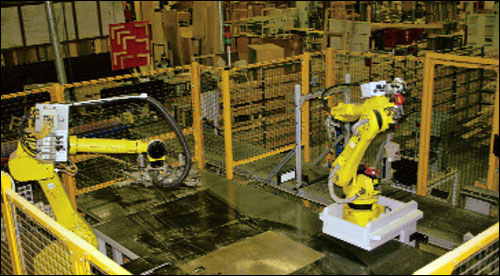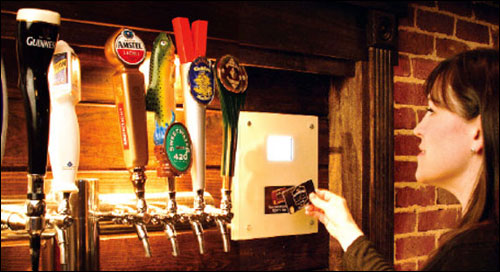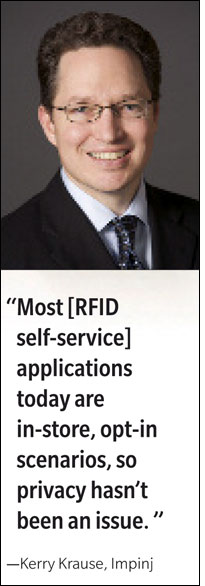Leading-edge technologies don’t stay on the leading edge very long unless they continually evolve into new applications and adapt to emerging user demands. This is certainly true of radio frequency identification, which began its commercial life as a straightforward retail asset-tracking technology and has since moved into manufacturing, health care, environmental monitoring, human and animal identification, security applications, transportation management and a variety of other fields.
As the second decade of the 21st century unfolds, RFID is increasingly leveraging other cutting-edge technologies and activities, such as smart phones, social networking and robotics, to create a new range of innovative business and consumer applications. “We’re on the cusp of the next phase,” says Drew Nathanson, director of operations for Natick, Mass.-based VDC Research. “RFID is getting an entire new look.”
|
|
Next-generation RFID applications are the result of years of steady progress, including thousands of pilot projects and trial deployments, according to Nathanson, as well as an ever-deepening pool of powerful and sophisticated RFID system-development tools. Early projects are now proving their value, inspiring enterprises of all types to move forward with more advanced initiatives. “Businesses are scaling and deploying,” he says. “In many different ways, RFID is moving to the next stage.”
Smart Phones
Thanks to the technology’s pending integration with smart phones, RFID is poised to move from loading docks, warehouses and other commercial venues into users’ hands. Analysts see the transition as part of a natural technological evolution. “It’s an inevitable next step, given the current path of both fields,” Nathanson says.
On today’s smart phones, voice communication almost seems an afterthought. Users are increasingly moving beyond conventional voice calls to engage in text and video messaging, Web surfing, media streaming and other activities that make speaking and listening either irrelevant or less significant. “Smart phones provide a communications environment that’s virtually ready-made for RFID,” Nathanson observes.
An upcoming generation of smart phones incorporating Near-Field Communication (NFC) capabilities will give users what amounts to their own personal RFID tags, allowing them to effortlessly purchase an almost endless range of products and services. With an NFC-equipped smart phone, consumers can forget about exchanging money with store clerks or fumbling with point-of-sale terminals. Instead, an individual will complete a transaction simply by pointing a phone at a box or sign.
“Think of NFC as a contactless technology that allows you to transmit data,” says Jeff Miles, worldwide director of mobile transactions for chipmaker NXP Semiconductors, in Eindhoven, The Netherlands. “If you look at the point-of-sale infrastructure both in the U.S. and globally, that’s a place where NFC can be used.”
Besides helping smart phone users buy all sorts of merchandise, the technology can be used to prove the user’s identity, as well as to gain access to events, trains, buses, theme parks and hotel rooms. “Don’t cubbyhole NFC as being just about contactless payment,” Nathanson advises. “You have ticketing, passports and other kinds of [identification] applications—you can even use [NFC] to transfer secure data and then use another device, via Bluetooth, to quickly send it someplace else.”
NFC technology has been around since about 2002, when it was codeveloped by NXP and Sony. Yet market adoption has been slow, mostly due to infighting between industry players. “Everybody wanted a piece of the pie,” Nathanson says. “Not just the handset guys and the chipmakers, but also the carriers and the banks [that operate the payment systems].”
But Nathanson and many other industry observers feel the dust is finally beginning to settle. There’s a growing belief that most major handset makers will soon begin shipping NFC smart phones. Nokia, for instance, announced in June that beginning in 2011, all its smart phones will come with built-in NFC capabilities. Apple, meanwhile, has filed a series of RFID-related patent applications, leading to speculation that the company will build NFC support into its iPhones and perhaps its iPod touch, iPod nano and iPad products as well.
With NFC smart phones hovering on the horizon, bank-card providers are starting to prepare their payment infrastructures for mobile contactless purchases, and conducting pilots worldwide. A Visa pilot program in New York earlier this year, for example, allowed commuters to pay train and bus fares on selected lines with their mobile phones. Bank of America also launched a New York-based trial this year, letting shoppers use their NFC smart phones to pay for in-store purchases. “The pieces are beginning to fall into place,” Nathanson says.
Social Networking
While nobody’s suggesting that people will soon begin RFID-tagging their friends to monitor their movements and activities via Facebook, a growing number of enterprises are investigating the potential to integrate RFID with social networks. The goal for most of these organizations is to enhance the customer experience in a safe, secure and private manner while generating valuable marketing data. Combined RFID and social media applications “are showing up on the watch lists from various industry groups, even some that have nothing to do with RFID technology,” says Michael J. Liard, RFID practice director at ABI Research, a technology research firm headquartered in Oyster Bay, N.Y.
RFID can interact with social media in various ways. An NFC smart phone carried into a restaurant or bar, for example, can be configured to automatically send invitations, complete with directions, to its user’s social network of friends and colleagues.
Real-world applications are already appearing. At Izzy’s Ice Cream Cafe, in Saint Paul, Minn., an RFID system informs customers about the shop’s ever-changing menu. It updates the flavor signs within the store, and Izzy’s Web site displays a list of all available flavors—including the artisan varieties that are prepared in small batches and sell out quickly; the site is updated every three minutes. The system also uses social media tools, such as Facebook and Twitter, to alert customers whenever a new flavor becomes available.
Vail Resorts, meanwhile, is schussing into RFID-enabled social media with a system that connects skiers with their online friends and relatives. Back in 2007, Vail began installing RIFD chips in its season passes and lift tickets, automatically scanning the tags as guests move around the property. The technology speeds service and adds convenience by eliminating the need for customers to fumble with heavy winter clothing in search of their passes and tickets. “We use UHF tags that allow us to scan the tags through someone’s jacket,” explains Robert Urwiler, CIO of Broomfield, Colo.-based Vail.
Now, with its new EpicMix system, using hardware supplied by ODIN Technologies, Vail is taking its RFID technology to a higher level. RFID readers at all lifts will identify skiers and automatically log their accumulated vertical distance, ski days and resorts skied (Vail Resorts comprises five mountains—Vail, Beaver Creek, Breckenridge, Keystone and Heavenly). Later, users can compare their totals with friends and family via Facebook, and earn “pins” when they complete certain activities—skiing 50,000 vertical feet, for instance, or being the first to ski fresh powder on a particular day.
Vail’s goal is to gather customer data while driving social interaction, both mobile and on-site, to enhance sales. EpicMix is scheduled to be available at all five Vail Resorts mountain locations this winter. “People can connect EpicMix with their existing Facebook account—or set up a new Facebook account—which allows them to share all their activity on our mountains with their friends and family,” Urwiler says.
Liard notes that combining RFID and social networks can help businesses better understand their customers’ needs and desires, though adopters must be careful to respect users’ privacy or risk an avalanche of negative publicity. “Still, I think these applications can become very powerful if handled properly,” he says.
Robotics
Robots are used for a variety of industrial tasks and come in many different forms. Yet all robots have one thing in common: They won’t work unless they’re told what to do. Science-fiction movies notwithstanding, few robots are self-motivated. But RFID lets manufacturers and other robot users give their machines precise, detailed and easy-to-follow instructions.
RFID-driven robots are highly suitable for manufacturing lines in industries ranging from electronics to vehicle production and furniture assembly, says Gerry Hubers, business development manager for robotic components maker Murata Electronics North America. He explains the basic process: “As a device travels down the line, a tag is read, the robot automatically goes and picks up a [tagged] component, plugs in onto the device, and it goes on its way.”

RFID works better than bar codes and other identification technologies in most production environments, Hubers says. “RFID is nice because you don’t have to have line of sight,” he explains. Feeding data directly to robots via radio links—and not forcing the machines to stop work, seek out and visually read instructions from a bar code each time a new component arrives—speeds production time and minimizes costs. Tags can also store more detailed instructions than bar codes.
Custom Cupboards, a cabinetmaker in Wichita, Kans., uses an RFID-driven robotic system to build custom cabinet face frames. Cabinet materials are tagged after cutting, says Jason Harris, the company’s CIO. As the parts—anywhere from four to 10 pieces, depending on the model—reach the assembly stage, a pair of robots swings into action. “Each robot goes through a series of algorithms, and it builds the frame in the most efficient means possible,” Harris explains. “The robot… knows how many pieces it’s supposed to have. It’s all based on the tag; it tells the robot everything it needs to know.”
Besides accelerating production time and cutting costs, RFID-driven robots also create more consistent and higher-quality assembled products than other approaches, says Patrick Ervin, VP of global sales and marketing for Alien Technology, the Morgan Hill, Calif.-based company that supplied the RFID antennas for Custom Cupboard.
“The interaction between machine and RFID technology is something that will have significant growth over the next few years,” Ervin predicts. “It’s really the elimination of labor, which is what robotics is all about.”
M2M Communications
Machine-to-machine (M2M) communications refers to automatic data exchanges between many different types of objects—computers, smart phones, tablets, door locks, automotive components and environmental sensors—without any direct human intervention. That breadth opens the door to a wide range of potential RFID applications.
While many RFID industry players and observers have long pegged M2M communications as a technology to watch, real-world uses haven’t yet lived up to expectations, at least when compared with basic tracking applications. But things are changing.
M2M is now widely used for environmental monitoring. Many hospitals and medical facilities, such as Southeast Alabama Medical Center, in Dothan, Ala., already rely on the technology to continuously monitor the condition of temperature-sensitive pharmaceuticals. “It helps cut waste by ensuring that our pharmaceuticals are kept under optimal conditions,” says Scott Lapham, a senior network engineer at the medical center. A growing number of warehouses and long-haul shippers are using RFID M2M technology to keep tabs on the condition of frozen foods, fresh produce, flowers and other temperature- and humidity-sensitive merchandise.
Now, RFID M2M is moving into more areas. “In the last few years, RFID M2M technology has been gaining acceptance in fields of applications such as video surveillance, telemetry and remote control,” says Neelima Sagar, an RFID analyst at the Mountain View, Calif., branch of technology research firm Frost & Sullivan, noting that in these areas and many others, RFID M2M solutions can often be integrated into existing network deployments. “[RFID M2M] technology is expected to witness a significant increase in revenues by 2013… since there is a need across industries to reduce cost, improve productivity and improve quality of service,” Sagar says.
Eric Krauss, director of M2M product management for AT&T, in Dallas, agrees. “Some of the areas that both we inside AT&T and industry analysts in general see,” he says, “are the monitoring of vehicle components, pipelines, copiers and other types of office equipment.” In all these cases, computers will be able to use collected data to alert users to service life benchmarks, potential device failure or the need to replenish a critical supply, such as oil or toner. “We’ll also certainly see medical devices being connected to send data back and forth to each other via the cloud, generating data that can then be accessed by medical professionals,” Krauss adds.
Yet even with M2M communications finding a home in so many different niches, potential adopters still find it difficult to obtain the basic software necessary to get their projects started. “There is no common platform or standard platform developed specifically [for RFID M2M],” explains Navid Yazdi, CEO of Evigia Systems, an RFID systems vendor in Ann Arbor, Mich., that often works with RFID M2M customers. “Essentially, we need to have the means to be able to enhance existing applications or launch new applications.”

To attract RFID M2M customers to its network, AT&T helps potential adopters find the right tools for their planned deployments. “We will help them identify the hardware vendors that work in their space and make introductions,” Krauss says. Yet, he admits that AT&T’s coaching effort has its limits. “Enterprises also have to do some of the IT development work themselves,” he says.
Still, companies are becoming more aware that RFID M2M’s benefits usually far outweigh its costs, Sagar says. “The three most important factors expected to drive growth in the M2M market include increased productivity, enhanced customer service and compliance with regulatory requirements,” she observes. “Moreover, the technology’s ability to provide enhanced customer service is translating into more business.” M2M also can be used to improve environmental protection, Sagar notes, “by [providing] the real-time and remote monitoring of resource use, and early warning of natural catastrophes.”
Self-Service Retail
RFID for retail self-service is still an emerging field, but it’s beginning to show significant progress as early testers and adopters continue exploring the technology’s potential. “There has been quite a bit of work put into proving the technical feasibility of UHF [ultrahigh-frequency] RFID for point of sale and elsewhere, yet the number of real-world deployments is relatively small, but growing,” says Kerry Krause, VP of marketing for Impinj, a Seattle-based UHF RFID systems provider.
The retail market has three primary players—the retailer, the supplier and the customer—and each can benefit from RFID self-service applications, Krause says. The retailer gets increased inventory visibility, which leads to a reduction in out-of-stocks and a sales lift; the retailer also gets more efficient checkouts less prone to human error. The supplier gets a sales boost from reduced out-of-stocks, too. The customer, meanwhile, benefits from an enhanced retail experience, including personalized service and faster checkout.
The ultimate RFID self-service technology is an automated checkout process that allows a shopper to simply push a cart full of tagged merchandise before a reader. But Krause thinks such a scenario is still a distant prospect for most retailers. “This might be economically feasible in the near term for an apparel or high-end product store, but we’re years away from having most items tagged in a grocery store,” he says. “In the meantime, it will be fun to watch innovative in-store uses of RFID grow.”
Krause points to Freedom Shopping, of Hickory, N.C., and 5-Stat, of Beatrice, Neb., as two top RFID self-service innovators. Freedom’s unattended checkout kiosk lets shoppers do their own in-store self-checkouts. The system supports cash payments, credit cards, store accounts and loyalty cards. It also integrates with existing point-of-sale systems.
5-Stat’s RFID-driven retail technology links merchandise to interactive displays designed to create an environment for informative yet entertaining customer engagement. Simply picking up a product at a Smart Display kiosk gives customers a wealth of details, including product options and accessories, matching merchandise and celebrity-endorsement videos.
On the very leading edge of RFID self-service innovation is DraftServ Technologies, an Atlanta-based company that markets a hosted draft beer management-and-control system to brewpubs and other restaurants that serve large quantities of liquid amber ambrosia. RFID-powered self-service lies at the heart of DraftServ’s business model. “We basically built our company around DraftMagik, which is our patent-pending service,” says Jerry Bucher, DraftServ’s cofounder.
DraftMagik taps deliver beer to the “point-of-pour”—the tables where the suds are consumed. The technology allows businesses to experiment with new sales techniques. A restaurant’s beer club members, for example, using tagged cards or wristbands, can use the self-serve system to pour full glasses or sample various brews two ounces at a time. Self-service helps drive up restaurant beer sales, Bucher says, and increased beer consumption leads to more food sales. Additionally, since the system tracks every ounce of beer dispensed, employees can’t cheat it, and customers don’t overserve themselves. DraftServ’s system has resulted in revenue increases of up to 15 percent per keg, Bucher says.
The primary challenge facing any RFID self-service technology adopter, Krause notes, is selecting the “taggable” products that will deliver a compelling return on investment. Integrating RFID into existing processes and securing data from hackers and spies are other big concerns. “Most applications today are in-store, opt-in scenarios, so privacy hasn’t been an issue,” he adds.
In the years ahead, self-service RFID will likely pop up in all sorts of places, not just stores. “I expect increased adoption in other closed-loop retail/service applications such as amusement parks, cruise ships, casinos and so on,” Krause says. “The technology is ready; now, innovative retailers and technology companies are working together to use RFID in a myriad of unpredictable ways.”
You Say You Want an Evolution?
Whether it’s smart phones, social networks, robotics, M2M or retail self-service, RFID 2.0 progress is likely to move forward incrementally, rather than in big leaps. Pilot projects and the experiences of early adopters will help interested enterprises uncover the most promising technologies and practices, and reject concepts that proved to be flawed or counterproductive. As always, the bottom line for any RFID investment will be cost savings and revenue opportunities.
“We’re just at the beginning of RFID innovation,” Nathanson says. “I think you’ll see innovation going on like crazy, especially as all the technologies get better understood.”
Stay tuned.





